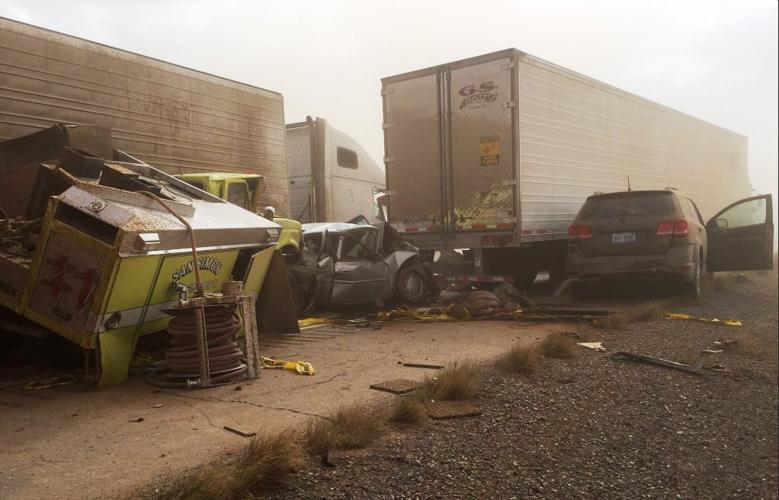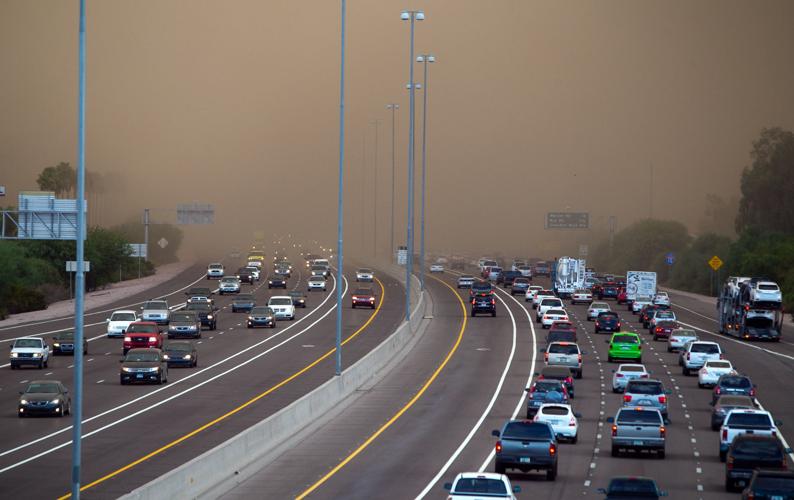This week, as storm-driven dust caused crashes on Interstate 10 near Picacho and blew a haboob into Phoenix, weather researchers called dust a deadly and underrated weather hazard in Arizona.
Dust storms are the third largest cause of weather fatalities in the state over the last 50 years, concluded a report published Tuesday by meteorologists with the National Weather Service and a University of Arizona atmospheric sciences researcher.
Fatalities from extreme heat or cold rank first and flash flooding is second, according to the report.
In terms of injuries, dust leads the list, and the number of deaths attributed to blowing dust might be higher if researchers could quantify the correlation between episodes of blowing dust and deaths from valley fever or respiratory failure.
The information updates an earlier study, said Glenn Lader, meteorologist with the National Weather Service in Tucson and a study author. The hazard rankings haven’t changed since that 2008 study, but public interest in the subject has grown, he said.
Lader said the weather service has also gotten better at predicting and issuing alerts about thunderstorms and the downdrafts that push dust ahead of them. “We’re making great strides, but there is still a lot of work to do,” Lader said.
As Lader spoke from his desk at the weather service office on the campus of the University of Arizona on Wednesday, he kept an eye on an array of monitors, one of which was showing radar images of a storm cloud blowing up 40,000 feet into the air in the vicinity of Interstate 10 and Valencia Road.
Some of his colleagues rushed to the window wall of the office, which faces south, to watch the towering cloud unleash a dark gray wall of water, which pushed dust ahead of it in all directions. “That wasn’t there 10 minutes ago,” said Tucson chief Mike Cantin. Ten minutes later, it had mostly dissipated.
Like many dust-pushing storms, it popped up so quickly that it was difficult to warn about it ahead of time.
That’s why the report, in addition to quantifying the carnage caused by dust, suggests mitigation of dust-prone areas along the highways, as well as technical improvements to the warning systems employed by the National Weather Service — more remote sensors and better modeling of the giant dust storms known as haboobs.
According to the report, 157 people died and 1,324 were injured in 1,521 “dust incidents” on Arizona highways between 1955 and 2011.
Many of the deaths came during spring winds or summer thunderstorms in the months of April and July — the deadliest months for dust.
Nearly half occurred along interstate highways in the southern desert regions, which include the state’s major metropolitan areas and heavily traveled interstate highways.
On Interstate 10, the accidents are concentrated in two agricultural belts — one in Pinal County between Phoenix and Tucson and the other in Cochise County from Benson to the New Mexico state line.
The major culprit, according to the study, is abandoned farmland “exacerbated by further disturbance of the land such as all-terrain vehicles (ATVs) or animals.”
Active farmland can also produce dust, according to the report, in the time between tilling and planting.
“This tilling process creates a period where the land is more susceptible to blowing dust as the soils have been disturbed, thus resulting in lower wind thresholds for airborne dust before a new surface crust reforms.”
The report identifies other potential health consequences of blowing dust, including a potential link between dust storms and valley fever, which is caused by the subsurface fungus coccidioides, which can easily become airborne when soil is disturbed.
Researchers had documented a link between a massive 1978 dust storm and reports of valley fever infections in California, but Arizona researchers were unable to find any such correlation in an investigation of the aftereffects of a gigantic haboob that blew through Phoenix and its suburbs in July 2011.
Dr. John Galgiani, who heads the University of Arizona’s Valley Fever Center for Excellence, said no spike in valley fever infections followed that storm.
“As spectacular as the dust storms are, they are not a real driver of valley fever case rates,” Galgiani said.
Galgiani said public health officials are still convinced a dust storm can spread the disease. “You would think it would and maybe it does,” he said.
The fungal spores are small and can be lofted by light breezes, he said. Big storms of short duration are apparently not the main cause of the disease, which killed 42 people in Arizona in 2014, according to the Arizona Department of Health Services.
Dust storms contribute to respiratory problems, but that effect is also hard to quantify.
The storms’ contribution to air pollution needs further study, said Aishwarya Raman, an atmospheric scientist at the University of Arizona and one of the study co-authors.
Raman is building a model of the towering haboobs that blow into the Phoenix area about three times each summer. That could help predict their initiation and path and also describe the components of the dust cloud.
“What has not been done is to actually monitor the pollution.
“I’m trying to see where the dust starts, what are the prominent dust sources and how they travel and how fast they travel.”
Better and more high-resolution sensing is needed, from satellites and from ground sensors, she said.
The report notes progress on ground sensors that will provide visual evidence of small dust storms that aren’t caught on radar.
A network of nine low-tech, low-cost sensors has been deployed along Interstate 10 in the dustiest region of Pinal County near Picacho.
The prototypes haven’t worked flawlessly, said Ken Waters, hazards coordinator for the Phoenix office of the Weather Service. In the past couple months, five of them have dropped off their computer network.
He expects a next generation of sensors to solve the problems he is encountering. The Arizona Department of Transportation recently qualified for a federal grant for improvements along the Picacho stretch of I-10 that includes money for dust-warning sensors.
In addition to the safety and public health threats, dust storms have an economic impact on the state, the report said.
Dust storms routinely cause closures of the interstate highways and haboobs can shut down air traffic at Phoenix Sky Harbor International Airport, said Lader.
The report concludes:
“Blowing dust is a significant underrated meteorological hazard in Arizona with impacts across many disciplines and sectors of the economy including transportation, public health, and air quality.”









